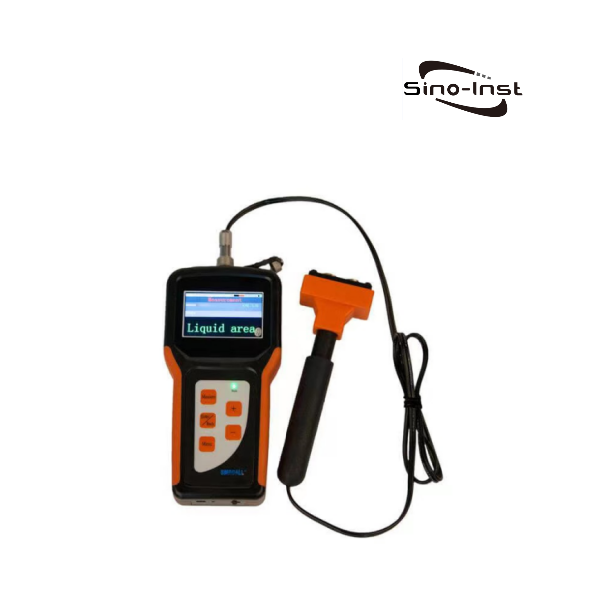
Radar and Guided Wave Radar Level Transmitter are often used in tank level measurement. Radar Level Transmitter and Guided Wave Radar Level Transmitter both use the principle that electromagnetic waves will be reflected on the surface of the medium to measure the level.
From a simple appearance, the Guided Wave Radar Level Transmitter has one more rod (cable) than the Radar Level Transmitter, and electromagnetic waves propagate along the probe rod. Next, let’s look in detail at the differences between radar level transmitters and guided wave radar level transmitters.
Difference parameter Between Radar and Guided Wave Radar Level Transmitter
First of all, you can learn about the detailed technical parameters, advantages and disadvantages, working principles, etc. of radar level transmitters and guided wave radar level transmitters from our product page.
Different ways of contact
Radar Level Transmitter is non-contact, and Guided Wave Radar Level Transmitter is contact.
In other words, GWR cannot be used in situations where food grade requirements are higher.
Different working conditions and media
- Radar Level Transmitter has a wide range of applications and can measure almost all media;
- From the shape of the tank body, the radar level gauge can measure the liquid level of spherical tanks, horizontal tanks, cylindrical tanks, cylindrical cone tanks, etc.;
- In terms of tank function, it can measure the liquid level in storage tanks, buffer tanks, microwave pipes, and bypass pipes;
- In terms of the measured medium, liquids, particles, slurries, etc. can be measured.
Guided Wave Radar Level Transmitter needs to consider the corrosiveness and adhesion of the medium, and it is more difficult to install and maintain a guided wave radar that is too long.
- Guided Wave Radar Level Transmitter has strong ability to suppress steam and foam, and the measurement will not be affected;
- It is not affected by the density of liquid, the looseness of solid materials, temperature, and dust during feeding;
- Low maintenance, high performance, high precision, high reliability and long service life.
Regarding different media situations, I think “Doug Anderson VEGA Controls Ltd” summarized it very well. It’s available for everyone’s reference. Here we quote it:
| Product/process requirements | Non contact Radar | Guided Radar (TDR) |
| Abrasive product | 1 | 0 |
| Adhesive product | 1 | 0 |
| Aggressive product | 1 | 0 |
| Agitated process/Viscous product | 1 | 0 |
| Extreme Product/Process temperatures | 1 | 0 |
| Heavy Condensation/Steam | 0 | 1 |
| High process Pressures | 1 | 1 |
| Low product reflectivity/dielectric constant <1.4 | 0 | 1 |
| Interface measurement (i.e.oil/water) | 0 | 1 |
| Narrow vessel | 0 | 1 |
| Obstructions in vessel | 1 | 1 |
| Standpipe/Bridle/Stilling tube | 0 | 1 |
| Foam on surface | 0 | 1 |
| Mounting/Nozzle interference | 1 | 0 |
| Overfill | 0 | 1 |
| Adaptability of a device | 1 | 0 |
| Ease of installation in application/maintenance | 1 | 0 |
| Mechanical fitting-size | 0 | 1 |
| 10 | 10 |
Different product selections
Common Radar Level Transmitter can be used interchangeably.
The Guided Wave Radar Level Transmitter generally cannot be used interchangeably because the length of the waveguide rod (cable) is fixed according to the original working conditions. Affected by this, the selection of guided wave radar is more troublesome than that of ordinary radar.
Different measuring ranges
Ordinary Radar Level Transmitter is commonly used on tanks of 30 and 40 meters, and can even measure up to 150 meters.
The guided wave radar Level Transmitter can measure up to 30m.
Guided Wave Radar Level Transmitter also needs to consider the force of the waveguide rod (cable). Due to the force, the measurement distance of guided wave radar is generally not very long.
However, in some special working conditions, the Guided Wave Radar Level Transmitter has obvious advantages. For example, there is stirring in the tank and the medium fluctuates greatly. In such working conditions, the measured value of the guided wave radar with a fixed bottom is more stable than that of the flexible radar.
There is also material level measurement in small tanks. Due to the small installation and measurement space (or there are many interference objects in the tank), ordinary Radar Level Transmitter is not suitable. At this time, the advantages of guided wave radar appear.
More Featured Level Measurement
In order to better choose suitable liquid level measurement equipment, it is best for us to understand the Difference Between Radar and Guided Wave Radar Level Transmitter in advance, as well as their installation, maintenance and other requirements.
We, Sino-Inst, are a professional manufacturer of radar level transmitters and guided wave radar level transmitters. We produce 26GHz, 80GHz radar level transmitters and guided wave radar level transmitters in various probe rod forms. If you have any questions about the Difference Between Radar and Guided Wave Radar Level Transmitter, please feel free to contact us!
-1.jpg)









